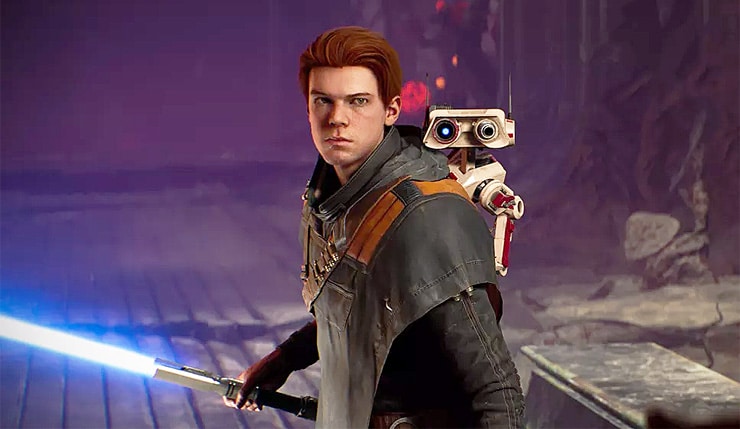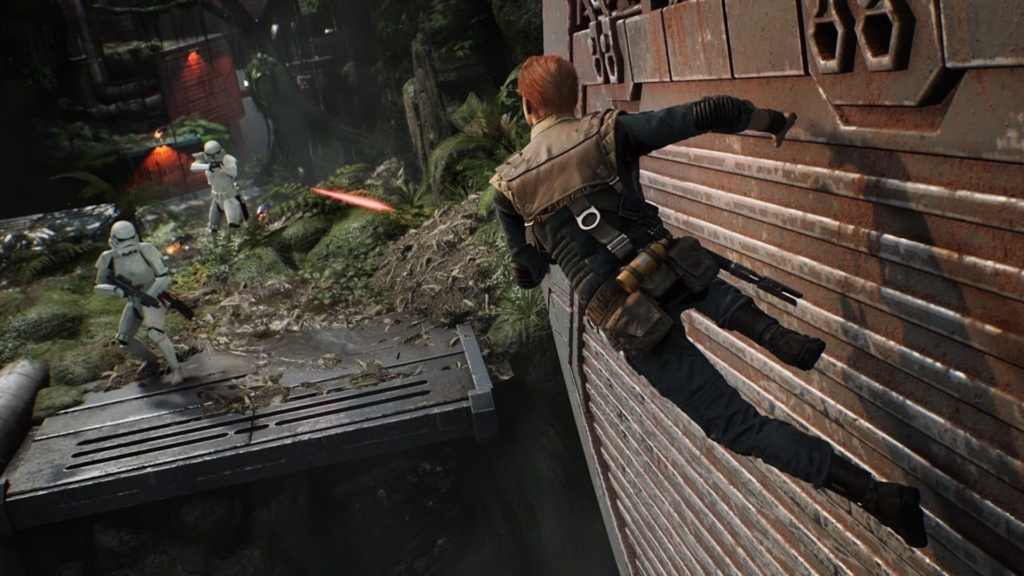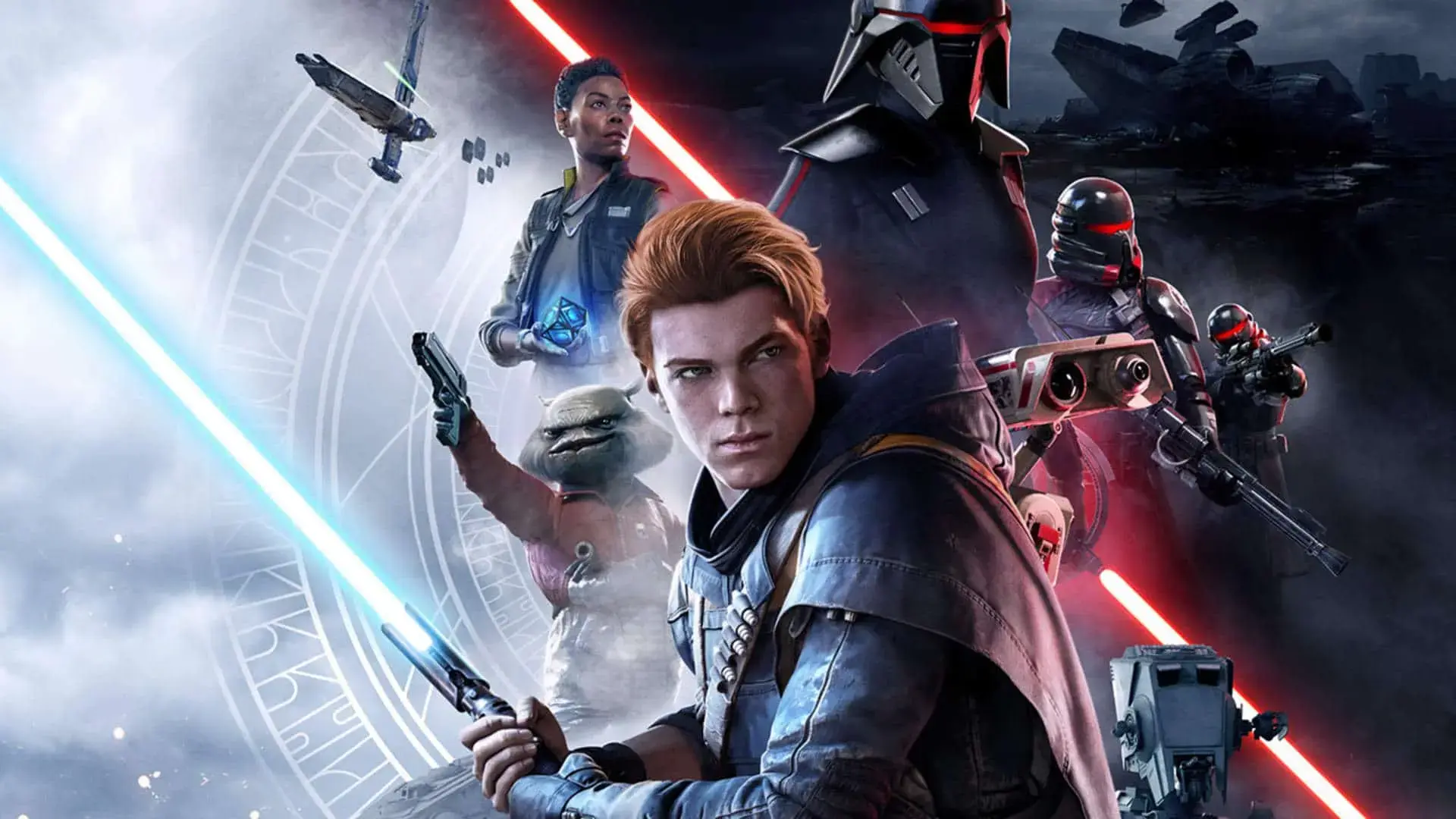Star Wars Jedi: Fallen Order Review
-
Something different for a Star Wars game
-
Strong Storyline
-
Nailed nostalgia in sounds and character appearances
-
Older hardware will struggle
-
Annoying save/death mechanics
Star Wars Jedi: Fallen Order slides perfectly into the action-adventure genre, but it hit me a little differently to other Star Wars games. Set in a troubled time in the Star Wars universe, between episode 3 and 4 after Vader and Palpatine cleared out the Jedi Order, it takes a darker turn in unexpected places.
On the flip side, this instalment of the Jedi games is fast-paced, emotionally intelligent, and has the fun mechanics you might recognise from the Uncharted series. I’d say the creators, Respawn Entertainment and EA, have also taken considerable inspiration from Dark Souls. This isn’t an easy action explorer. Star Wars Jedi: Fallen Order is a damn hard single-player in places as you guide your red-headed Jedi, Cal Kestis, across the galaxy and slowly see the extent of his guilt at surviving the Order 66 massacre.
Cal’s Emotional Narrative
I grew up on Star Wars, and the games have always tickled that nostalgia itch if nothing else. The story and character in Star Wars Jedi: Fallen Order honours source material in a way lifelong fans will notice. Some of the old, lovable tropes are in there, like Clone troopers who can’t shoot straight—or yell hilariously ironic one-liners before being obliterated. The core of the narrative is what drew me forwards, though. This is a story-driven third-person game, and we join Cal and his mentor, Cere, at a morally difficult time. Ultimately, you have to beat the Imperial army to a set of coordinates, showing the locations of many younglings with force sensitivity.
The act of finding the coordinates immediately puts the onus on what you’re going to do with them, and the journey through Cal’s thought processes and experiences add a layer of maturity to the game. Choice isn’t the only challenge for our Jedi hero. The Imperial Inquisitor, the Second Sister, has a surprising connection with Cal’s mentor, Cere. As a betrayed Padawan of Cere’s in the past, I found the exploration of their relationship fascinating and gripping. More so than I felt, at any point, for Cal’s inner turmoil. At no point does Cal really seem tempted by the dark side, whereas Cere’s entire character arc is built around her struggle with it.
Supporting characters evolve nicely in the corners of the plot, with BD-1 fulfilling the friendly robot role and ship captain Gris providing some much-needed comic relief to the misfit ensemble.

Flashback scenes serve as convenient, playable methods of exposition as the game goes on. Training as tiny Cal brought me closer to his character than I felt during most of his present-day interactions. Overall, I got the impression that Cal was a bit moody and stuck-up—probably not what EA intended! He treats Cere with derision for the most part, and it’s only his adorable bond with BD-1 that gives him a softer side.
I feel what made the storyline so enjoyable with these characters was, at its heart, it has the feeling of an underdog story. The Jedi have fallen, there’s no one coming to help Cal and his friends, and the Imperial army is seemingly unbeatable at this point in the timeline. Despite all that, the game makes you feel like the force really guides you through the, sometimes, dark narrative alongside the occasionally tricky gameplay.
Fast-paced Gameplay and Cruel Save Mechanics
Adventuring through the red dusty atmosphere of Kashyyk or the astounding green jungle of the Wookie’s home planet, every location has its story to tell as I make my way to my objective. Everywhere the main quest takes you, you get a sense of the depths of the planet by exploring barren caverns, icy, ancient temples, and underground networks of shadowy tunnels. More than a few times, I wondered where I was supposed to be going, and that’s due to the minimal HUD that would usually clutter your screen.
As you can tell, despite sometimes getting lost or stuck in a dead-end location, I appreciated the sense of freedom this gave me. Oftentimes I’d totally missed a puzzle that was waiting to be solved to open the next area. If you imagine Lara Croft level puzzle-solving, you wouldn’t be far off, and they don’t disappoint. It was hugely satisfying to figure out which giant Imperial power cords fit what plug to open a cell or perfectly align a set of crystals to melt a frozen cave entrance. The puzzle mechanics aren’t repetitive or boring, though. In fact, I’m never too proud to admit that I reached for a walkthrough once to figure out how to time freezing a moving wheel just right, so I could make it up to the next level at last.
Star Wars Jedi: Fallen Order forces you to get around in the most complicated ways. As I progressed in the beginning, I learned how to leap to impossibly high ledges, and parkour run sideways along ridged walls and slide through low gaps. Timing is everything in some of these high-octane scenes, and jumping across falling boulders is exactly as tricky as it sounds. The way you hardly ever just walk anywhere reminded me of the early Assassin’s Creed games, where you had to carefully pick your next step or risk falling to your death. I felt like that for most of the planets, with concentration set to high as I had to pick just the right ledge to jump up to or I’d get stuck.

Once I started to unlock the (very cool) force abilities through gradual flashback scenes, things got more exciting. I bent, crumpled, froze, and force-pushed every obstacle out of my way. It really is fun to experience the Jedi power in this game and is made to feel more precious because of its scarcity. The skill-tree is straightforward for upgrading Cal’s powers when meditating, and it drives you to chase those skill points.
Force powers weren’t only useful for getting around, though. During combat, you can use force moves that could be unlocked in an upgrade screen, and these moves are specific to enemy types, so choose carefully. The lightsabre is the only weapon Cal uses, and you have to use it to break the block bar of enemies before you can cause damage. Side-rolling, dodging, and blocking are crucial skills I had to learn fast for the bigger melee enemies like Imperial military droids.
While I was killing, exploring and clearing areas with my powers, lightsabre, and cute BD-1 buddy, I discovered that finding chests and Jedi echoes was extremely helpful. Some chests contained enough force capacity or health canisters to get me through a combat area that I would’ve otherwise died in. The locations draw you onwards with these urges to discover everything, try out your new powers, and most importantly—to upgrade your very own lightsabre.
That’s right. Upgradeable lightsabre! Need I say more?
Inside chests, you’ll find weapon components and upgrade materials. As you collect the materials you want, you can find a weapons worktable (there aren’t many around, so I had to pick my upgrade opportunities wisely) and craft until you have the lightsabre you always dreamed of. Once you’ve passed a certain point in the game, you’ll also have the option of a truly drool-worthy dual-ended lightsabre. This fact alone made me give this game another half a star.
Even with these cinematic force moves and lightsabre tricks, there’s one aspect that brings Jedi: Fallen Order to a higher difficulty level. Let’s talk saves and deaths. This is where the Dark Souls vibes come in. There is no save progress function, and you must rely on ‘meditation’ checkpoints after you clear and make it through each progressive area. When you meditate on these checkpoints, your progress is saved, and your health is replenished fully.
The issue is that these checkpoints sometimes feel perilously distant from each other, and placed in cruel points where you might have to travel through a difficult area AND defeat a mini-boss to make it to the meditation spot and save. I repeated areas more than once because I died just before reaching the save point, and it was annoying. You also aren’t allotted a whole lot of health or force capacity, meaning three or four hits from even a medium enemy will kill you. If you die from either enemies or falling, you will respawn with almost full health back at the last place you meditated, which kicks back some of your progress. Dying and respawning sadly respawns all enemies in the area along with you, just like Dark Souls.
When it comes to skill points, if you died at the hands of an enemy, when you respawn to confront the enemy again, one hit will finish them and return all of your skill points, health and force. This seems to be a small apology from the creators, for making you die so often anyway.

Quality Visuals from Unreal Engine
There may be some justifiable criticism of Battlefront games, but Star Wars Jedi: Fallen Order is EA’s shining beacon of redemption, in my opinion. Built with EA’s Unreal Engine, this game easily compares to the Battlefront titles in terms of graphics quality. Every cut scene was fluid and natural, and I didn’t catch a noteworthy glitch throughout, only the occasional object cutting into textures, particularly with the lightsabres and Cal’s customisable ponchos (very fashion-forward of you, Cal). The classic Star Wars sounds are a highlight while playing, though, and often brought a smile to my face.
Overall, the game handled load-ins quite well, with some expected chops at the start of a new area. Playing on PC with a GeForce GTX 970 graphics card, I had no chance at glimpsing the ultra settings, but even on high quality I saw a lot of FPS drop and had to change the settings to reduce the load. Many gamers are playing on similar rigs without the highest spec components, so this is probably important to know if you’re thinking of playing this on older PC gear or Xbox One/PlayStation 4.
What should you know about Star Wars Jedi: Fallen Order?
- You’ll need to focus and master parkour moves in fast-paced sequences.
- Dark Souls-style save mechanics area challenging, but it makes success even sweeter.
- Upgradeable lightsabres, force powers and BD-1 add a little fun to an otherwise heavy storyline.

